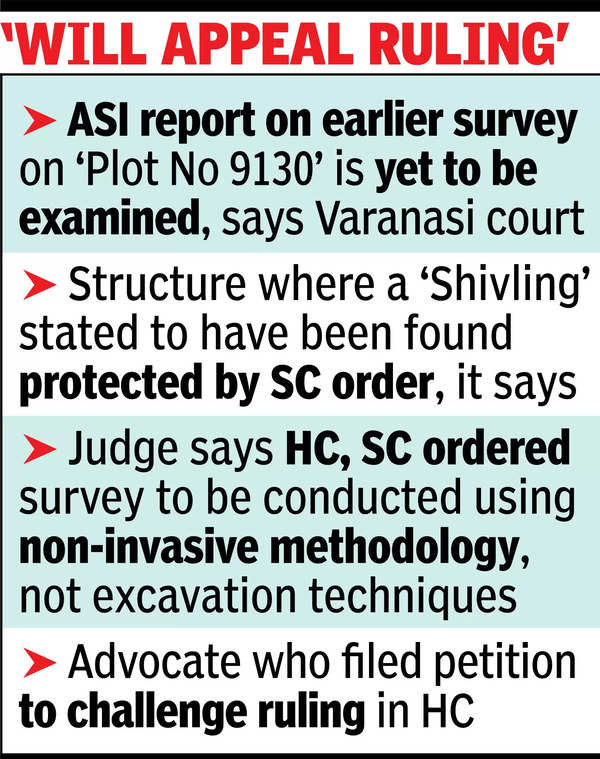VARANASI: A fast-track court in Varanasi rejected Friday a Hindu plaintiff’s plea for an “additional” survey by ASI of the Gyanvapi mosque complex, using invasive methods to gain access to purportedly razed remains of an ancient Adi Vishweshwar temple believed to exist beneath the central dome.
Civil judge (senior division) Yughul Shambhu cited directives from Supreme Court and Allahabad high court barring any excavation during the previous survey by ASI of “Plot No 9130” within the Gyanvapi complex.
“Based on the facts and circumstances, it can be concluded that the report submitted by ASI is yet to be examined. Secondly, the structure where a ‘Shivling’ is stated to have been found is protected by an order of Supreme Court,” Shambhu said.
The fast-track court reserved its order during the previous hearing on Oct 19 after Anjuman Intizamia Masajid, the mosque’s custodian, filed objections to advocate Vijay Shankar Rastogi’s petition seeking another survey by ASI.

Rastogi, who identifies himself as “next friend of Swayambhu Jyotirlinga Bhagwan Vishweshwar” in the original Dec 2019 plea for a survey to find out if the mosque was built over a demolished shrine, told reporters that he would appeal Friday’s ruling in the high court.
Gyanvapi is embroiled in multiple litigations, including the Shringar Gauri case filed in Aug 2021 by five women plaintiffs seeking unrestricted access to the mosque complex for daily worship of “visible and invisible” Hindu deities there.
Two previous surveys of the complex, one by a team constituted by the civil judge’s court and the second by ASI, have yielded purported findings that the Hindu side insists are proof of the existence of a temple.
The first court-mandated survey in May 2022 revealed the “Shivling” in the middle of the wuzukhana, or ablution pond. The then civil judge ordered that the pond area be sealed, while allowing namaz to continue. The same month, SC ordered status quo on the dispute and steps to protect the pond area. The apex court also transferred the case to the district judge’s court.
On July 23 last year, the district judge asked ASI to conduct a scientific survey of Gyanvapi in response to a plea from the plaintiffs in the Shringar Gauri suit. The survey was to cover the entire premises, barring the sealed wuzukhana zone, to “determine if the mosque had been constructed over the pre-existing structure of a Hindu temple”.
ASI submitted its report in a sealed envelope on Dec 18 last year, but it wasn’t opened until Jan 24. The fast-track court, which was separately hearing Rastogi’s plea for a survey of Gyanvapi, directed him to procure a copy of the ASI report before reworking his plea.
In compliance with the Dec 30 order, Rastogi submitted a fresh plea in Feb with references to the ASI report. He sought excavation of a trench to gain access to the purported sanctum sanctorum of the ancient temple that is presumed to have been demolished to build the existing mosque.
Rastogi contends that the shrine below the central dome houses a towering “Shivling” and an artesian well.
AIM and the Uttar Pradesh Sunni Central Waqf Board filed their objections against Rastogi’s plea on various grounds.
